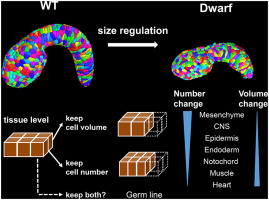当前位置:
X-MOL 学术
›
Dev. Biol.
›
论文详情
Our official English website, www.x-mol.net, welcomes your
feedback! (Note: you will need to create a separate account there.)
Different strategies for tissue scaling in dwarf tailbud embryos revealed by single-cell analysis.
Developmental Biology ( IF 2.5 ) Pub Date : 2020-01-22 , DOI: 10.1016/j.ydbio.2020.01.008 Kaoru D. Matsumura , Mitsuru J. Nakamura , Wataru C. Koizumi , Kohji Hotta , Kotaro Oka
Developmental Biology ( IF 2.5 ) Pub Date : 2020-01-22 , DOI: 10.1016/j.ydbio.2020.01.008 Kaoru D. Matsumura , Mitsuru J. Nakamura , Wataru C. Koizumi , Kohji Hotta , Kotaro Oka

|
The tailbud stage is part of the organogenesis period-an evolutionarily conserved developmental period among chordates that is essential for determining the characteristics of the chordate body plan. When the volume of the egg is artificially decreased by cutting, ascidians produce a normal-looking but miniature (dwarf) tailbud embryo. Although cell lineages during ascidian embryogenesis are invariant, the number of cell divisions in the dwarf embryo is altered by a different mechanism in each tissue (Yamada and Nishida, 1999). Here, to elucidate the size-regulation strategies of the Ciona robusta dwarf tailbud embryo, we compared anatomical structure, developmental speed, and cell number/volume in each tissue between dwarf and wild type (WT) embryos. To do this, we constructed a 3D virtual mid-tailbud embryo (Nakamura et al., 2012). We could make a Ciona dwarf tailbud embryo from eggs with a diameter over 108 μm (correspond to > 40% of the wild type egg volume). The timings of cleavage (~St. 12) and subsequent morphogenesis were nearly the same but blastomeres of animal hemisphere slightly delayed the timing of mitosis in the early cleavage period. Intriguingly, the tissue-to-tissue volume ratios of dwarf tailbud embryos were similar to those of wild type embryos suggesting that the ratio of tissue volumes is essential for maintaining the proper shape of the tailbud embryo. The number of cells in the epidermis, nervous system, and mesenchyme was significantly reduced in the dwarf embryos whereas the cell volume distribution of these tissues was similar in the dwarf and wild type. In contrast, the number of cells in the notochord, muscle, heart, and endoderm were maintained in the dwarf embryos; cell volumes were significantly reduced. Neither parameter changed in germline precursors. These results indicate that each tissue uses different scaling strategies to coordinate cell number and cell volume in accordance with the embryo size.
中文翻译:

通过单细胞分析揭示了矮尾巴胚胎中组织缩放的不同策略。
尾芽阶段是器官形成时期的一部分-脊索动物中一个进化上保守的发育时期,这对于确定Chordate人体计划的特征至关重要。当通过切割人为地减少鸡蛋的体积时,海鞘会产生看上去正常但微型(矮小的)尾芽胚。尽管海鞘胚胎发生过程中的细胞谱系是不变的,但矮人胚胎中的细胞分裂数目是通过每种组织中的不同机制而改变的(Yamada和Nishida,1999)。在这里,为了阐明罗汉果矮小尾芽胚的大小调控策略,我们比较了矮生和野生型(WT)胚之间每个组织的解剖结构,发育速度和细胞数量/体积。为此,我们构建了3D虚拟中尾巴胚胎(Nakamura等,2012)。我们可以用直径超过108μm(相当于野生型卵量的40%以上)的卵制成Ciona矮尾芽胚。卵裂的时间(〜St。12)和随后的形态发生几乎是相同的,但是动物半球的卵裂球在卵裂早期会稍微延迟有丝分裂的时间。有趣的是,矮尾巴胚胎的组织与组织的体积比与野生型胚胎的组织与组织的体积比相似,这表明组织体积的比率对于维持尾巴胚胎的适当形状至关重要。侏儒胚胎中表皮,神经系统和间质的细胞数量明显减少,而侏儒和野生型中这些组织的细胞体积分布相似。相反,脊索,肌肉,心脏中的细胞数量 内胚层保持在矮人胚胎中;细胞体积明显减少。种系前体中两个参数均未改变。这些结果表明每种组织使用不同的缩放策略来根据胚胎大小协调细胞数量和细胞体积。
更新日期:2020-03-30
中文翻译:

通过单细胞分析揭示了矮尾巴胚胎中组织缩放的不同策略。
尾芽阶段是器官形成时期的一部分-脊索动物中一个进化上保守的发育时期,这对于确定Chordate人体计划的特征至关重要。当通过切割人为地减少鸡蛋的体积时,海鞘会产生看上去正常但微型(矮小的)尾芽胚。尽管海鞘胚胎发生过程中的细胞谱系是不变的,但矮人胚胎中的细胞分裂数目是通过每种组织中的不同机制而改变的(Yamada和Nishida,1999)。在这里,为了阐明罗汉果矮小尾芽胚的大小调控策略,我们比较了矮生和野生型(WT)胚之间每个组织的解剖结构,发育速度和细胞数量/体积。为此,我们构建了3D虚拟中尾巴胚胎(Nakamura等,2012)。我们可以用直径超过108μm(相当于野生型卵量的40%以上)的卵制成Ciona矮尾芽胚。卵裂的时间(〜St。12)和随后的形态发生几乎是相同的,但是动物半球的卵裂球在卵裂早期会稍微延迟有丝分裂的时间。有趣的是,矮尾巴胚胎的组织与组织的体积比与野生型胚胎的组织与组织的体积比相似,这表明组织体积的比率对于维持尾巴胚胎的适当形状至关重要。侏儒胚胎中表皮,神经系统和间质的细胞数量明显减少,而侏儒和野生型中这些组织的细胞体积分布相似。相反,脊索,肌肉,心脏中的细胞数量 内胚层保持在矮人胚胎中;细胞体积明显减少。种系前体中两个参数均未改变。这些结果表明每种组织使用不同的缩放策略来根据胚胎大小协调细胞数量和细胞体积。











































 京公网安备 11010802027423号
京公网安备 11010802027423号